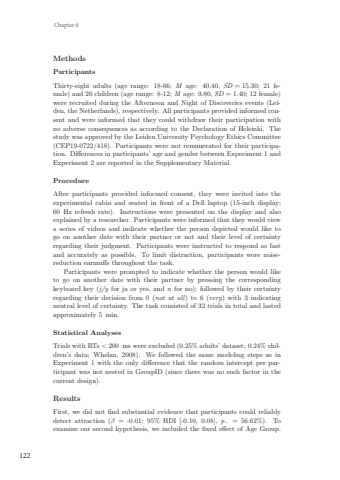Page 124 - Demo
P. 124
122Chapter 6MethodsParticipantsThirty-eight adults (age range: 18-66; M age: 40.40, SD�=�15.30; 21 female) and 26 children (age range: 8-12; M age: 9.80, SD�=�1.40; 12 female)were recruited during the Afternoon and Night of Discoveries events (Leiden, the Netherlands), respectively. All participants provided informed consent and were informed that they could withdraw their participation withno adverse consequences as according to the Declaration of Helsinki. Thestudy was approved by the Leiden University Psychology Ethics Committee(CEP19-0722/418). Participants were not remunerated for their participation. Differences in participants’ age and gender between Experiment 1 andExperiment 2 are reported in the Supplementary Material.ProcedureAfter participants provided informed consent, they were invited into theexperimental cabin and seated in front of a Dell laptop (15-inch display;60 Hz refresh rate). Instructions were presented on the display and alsoexplained by a researcher. Participants were informed that they would viewa series of videos and indicate whether the person depicted would like togo on another date with their partner or not and their level of certaintyregarding their judgment. Participants were instructed to respond as fastand accurately as possible. To limit distraction, participants wore noisereduction earmuffs throughout the task.Participants were prompted to indicate whether the person would liketo go on another date with their partner by pressing the correspondingkeyboard key (j/y for ja or yes, and n for no); followed by their certaintyregarding their decision from 0 (not at all) to 6 (very) with 3 indicatingneutral level of certainty. The task consisted of 32 trials in total and lastedapproximately 5 min.Statistical AnalysesTrials with RTs�<�200 ms were excluded (0.25% adults’ dataset; 0.24% children’s data; Whelan, 2008). We followed the same modeling steps as inExperiment 1 with the only difference that the random intercept per participant was not nested in GroupID (since there was no such factor in thecurrent design).ResultsFirst, we did not find substantial evidence that participants could reliablydetect attraction (β = -0.01; 95% HDI [-0.10, 0.08], p− = 56.62%). Toexamine our second hypothesis, we included the fixed effect of Age Group.Iliana Samara 17x24.indd 122 08-04-2024 16:36


